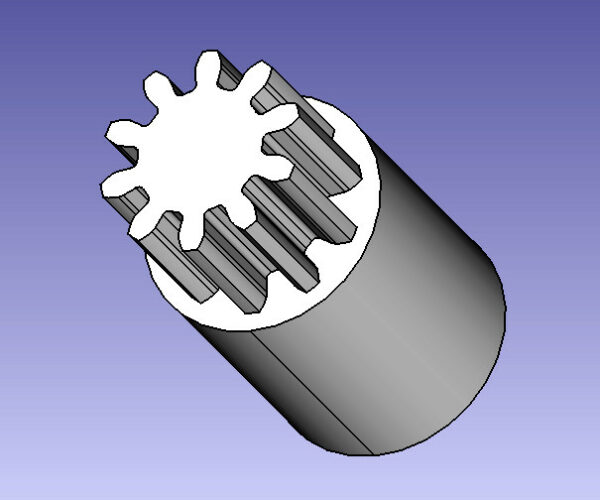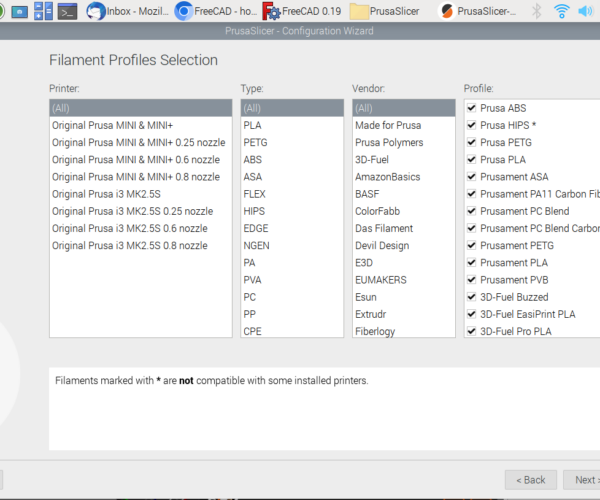FreeCAD - how to learn that
Hallo,
as one of my hobbies is 3D printing, I am also very interested in Raspberry Pi (these little computers). For 3D printing it is necessary to have a tool for designing your parts - a good choice is FreeCAD but in my own opinion it is not that intuitive as you may want it to be. On the other side it is free and open source which is a major advantage in my opinion.
Today I had a look into "HackSpace Issue #49" and found out that there is a FreeCad tutorial since Issue #37 (1. part of this tutorial). You can download these issues here:
https://hackspace.raspberrypi.com/issues
I know that on youtube there are lots of tutorials too, but it is worth having a look into HackSpace.
Best regards, Clemens
Mini, i3 MK2.5S, i3 MK4, CClone (Eigenbau)
RE: FreeCAD - how to learn that
A number of years ago when I first got into 3d printing I took a quickie course at our local 'makerspace' on drafting 3d models, and the tool that was used was FreeCAD, since it is free and thus equally available to all participants and also since it was available on all common platforms, and thus equally available as well.
The hands-on instruction got me started.
I'm also a Pi fan, got into that before I got into 3d printing. I'm a regular reader of MagPi and HackSpace and would recommend those to any and all. Both are free with an optional donation.
Those interested might look into if you have a makerspace or community college that has a quickie night course in something like this.
They started off simple, as in doing some simple geometric items in the Parts workbench, and then doing some actual drafting, again of simple items, using the Sketcher in the Part Design workbench.
The learning curve can be steep, but manageable. I haven't found much that can't be done with it.
One particular feature that I found very helpful is the 'involute gear' maker of FreeCAD. It takes some practice, but results have been great.
RE: FreeCAD - how to learn that
Maybe it is interesting for some of you - I had a look at Raspberry Pi repository today, as I am setting up a new raspberry pi 4 8GB with Raspberry Pi OS 64-bit and found that there ist the FreeCad version 0.19 available (see below).
OS: Debian GNU/Linux 11 (bullseye) (LXDE/LXDE-pi)Word size of OS: 64-bitWord size of FreeCAD: 64-bitVersion: 0.19.Build type: ReleasePython version: 3.9.2Qt version: 5.15.2Coin version: 4.0.0OCC version: 7.5.1Locale: English/United Kingdom (en_GB)
Playing around with it it seems working fine - so one step closer to use only a raspberry pi for all of my stuff.
Best regards, Clemens
Mini, i3 MK2.5S, i3 MK4, CClone (Eigenbau)
RE: FreeCAD - how to learn that
I have tried FreeCAD on the Pi 400. It's slow and sloppy compared to a more mainstream Linux desktop.
RE: FreeCAD - how to learn that
Are you running a 32-bit or 64-bit Raspberry Pi OS version - on 64-bit I am happy - never tried on 32-bit (read of lots of problems there)
Best regards, Clemens
Mini, i3 MK2.5S, i3 MK4, CClone (Eigenbau)
RE: FreeCAD - how to learn that
And - there is now a compendium of the different tutorials in HackSpace - download is available here:
https://hackspace.raspberrypi.com/books/freecad
Best regards, Clemens
Mini, i3 MK2.5S, i3 MK4, CClone (Eigenbau)
RE: FreeCAD - how to learn that
Are you running a 32-bit or 64-bit Raspberry Pi OS version - on 64-bit I am happy - never tried on 32-bit (read of lots of problems there)
Best regards, Clemens
I'm very sure it's the older 32 bit version. It's the 'desktop' down in the train room which I've used since the old Windoze peecee down there died.
It's easy to update, so I'll put that on the do-it list for this week and I'll report back. I'm downloading the current 64 bit image now. If nothing on it that I use regularly breaks, there's no reason not to stay with the new image.
RE: FreeCAD - how to learn that
I'm down in the train room now and I just installed the 64 bit bullseye on the Pi 400.
One of the first things I installed was FreeCAD and I am happy to say that the performance is much improved.
It is a bit slow loading a large model from a network share, but the response is just fine. It does not dog down at all or peg the CPU when doing such things as rotating a large model on the turntable.
I'm now continuously rotating a laptop base and doing Firefox and still have 75-86% idle on a 'top' display.
Now all I have to do is get everything else the way I want it. 😉
The nice thing about the Pi 400 is that it's trivially easy to boot on a different image. Just swap out the card.
RE: FreeCAD - how to learn that
As an aside, the PrusaSlicer image that runs on the old OS refuses to run on the new 64 bit bullseye. Ditto for the latest arm image.
LOL, do I dare try building it from scratch on this machine? 😉
RE: FreeCAD - how to learn that
I 1. tried this: PrusaSlicer-2.5.0+linux-armv7l-GTK2-202209060715.tar.bz2 - this is the 32-bit version which did not work on my 64-bit os.
I found this: https://github.com/davidk/PrusaSlicer-ARM.AppImage
Follow this guide and you can install the Prusa Slicer 2.5 (PrusaSlicer-2.5.0+linux-armv7l-GTK2-202209060715.AppImage ... I think it was that file)
That worked for me
Best regards, Clemens
Mini, i3 MK2.5S, i3 MK4, CClone (Eigenbau)
RE: FreeCAD - how to learn that
Thanks.
It looks like there's 'some assembly required' so I'll try it the next time I have some spare time down there and see if it will work for me. It sure looks like less work than trying to build it from source.
RE: FreeCAD - how to learn that
Sorry - I was wrong, it was this guide:
https://github.com/davidk/PrusaSlicer-ARM.AppImage/releases
And that was really easy to install,
best regards, Clemens
Mini, i3 MK2.5S, i3 MK4, CClone (Eigenbau)
RE: FreeCAD - how to learn that
It works, thanks. Started right up. On a large model it's definitely slower slicing than on the Ubuntu or the Windoze peecee, but it looks like it will be workable.
One item that seemed odd, and I admit I have not gone through the from-scratch PS install for some time, is that it says that FilamentPM PLA is 'not compatible' with one or more installed printers. LOL, that's actually the sample that ships with the printer. 😉
RE:
Maybe a silly question: Have you gone through configuration manager? Causse I have installed two printers MINI and MK2.5S and can select (I would say nearly) every filament which is known by default by PrusaSlicer.
Best regards, Clemens
Mini, i3 MK2.5S, i3 MK4, CClone (Eigenbau)
RE:
Yes, and I selected the base-level MK3S, the MK3S/MMU2S, and MK3S/MMU2S-Single.
Same as I have on the two machines (Linux, Windoze) I regularly slice with.
I've been aware that some of the filaments I've used regularly (particularly Hatchbox PLA/ABS) are supposedly incompatible with at least one of the above. (Those two print just fine.)
However, it kinda threw me that the FilamentPM PLA was marked as incompatible, as that's actually what is shipped as a sample with new printers.
I can see maybe a generic flex being incompatible with the MMU2S, but Hatchbox filaments are commonly used with all three of the above and work just fine.
RE: FreeCAD - how to learn that
I'm sure the one that 'breaks' the various types is the MMU2S.
RE: FreeCAD - how to learn that
Good point as I don't own a MMU as I am only printing functional parts and not models as you do! Sorry not beeing able to assist,
best regards, Clemens
Mini, i3 MK2.5S, i3 MK4, CClone (Eigenbau)
RE: FreeCAD - how to learn that
Actually, I seldom use the MMU anymore.
RE: FreeCAD - how to learn that
The easiest way to get Prusa Slicer running on a Raspberry Pi with Pi OS 64 Bit ist to install "fuse". Having done so you can execute these AppImage files without any problem. I use this one at the moment: PrusaSlicer-2.5.0+linux-aarch64-GTK3-202209071828.AppImage
Best regards, Clemens
Mini, i3 MK2.5S, i3 MK4, CClone (Eigenbau)


